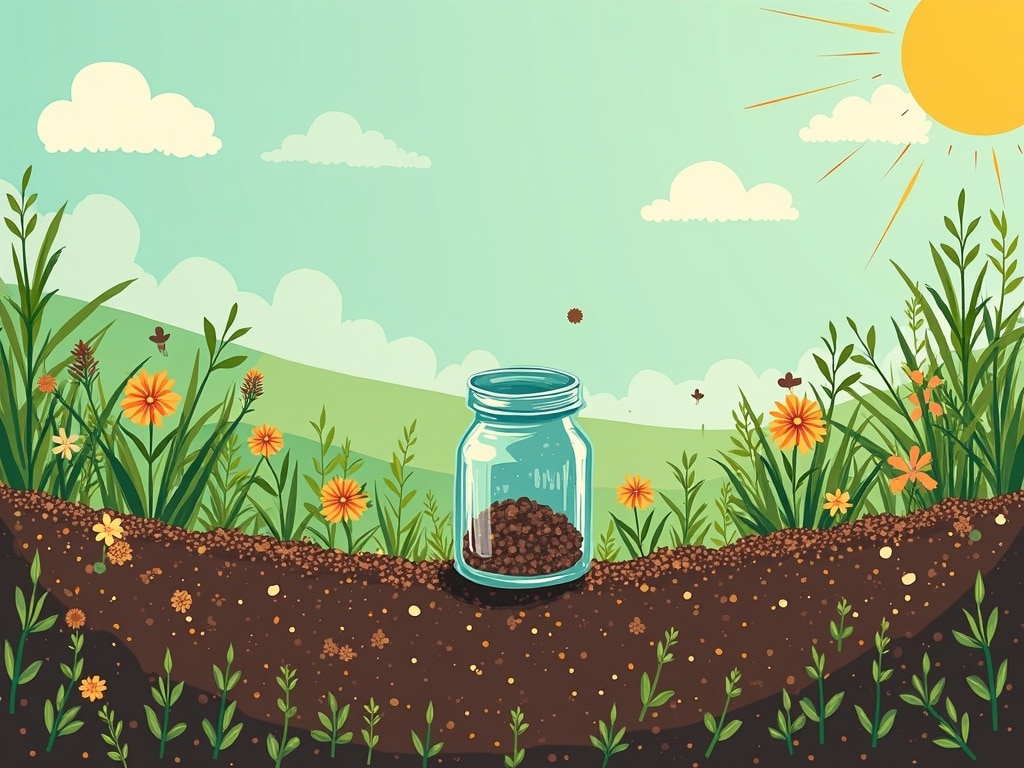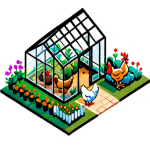Compost 101: Ditch the Landfill, Enrich Your Life (and Garden)!
What is Composting and Why is it Important?
Imagine turning your kitchen scraps and yard waste into black gold – a nutrient-rich soil amendment that breathes life into your garden. That's the magic of composting! But what exactly *iscomposting? Simply put, it's nature's recycling process. It's the decomposition of organic matter, transforming things like vegetable peels, coffee grounds, and leaves into a valuable resource for your plants.
Why is this so important? Landfills are overflowing with organic waste, which, when buried, decomposes anaerobically (without oxygen), producing methane – a greenhouse gas far more potent than carbon dioxide. By composting, you divert this waste from landfills, reduce methane emissions, and create a valuable, free resource in the process. It’s a win-win for you and the planet.
Benefits of Composting for Your Garden and the Environment
The benefits of composting extend far beyond reducing landfill waste. For your garden, compost acts as a natural fertilizer, enriching the soil with essential nutrients. It improves soil structure, allowing for better water retention and drainage. This means your plants are healthier, more resilient to diseases, and require less watering. Think of it as a superfood smoothie for your soil!
- Reduces the need for chemical fertilizers: Compost provides a slow-release of nutrients, naturally feeding your plants without the harsh chemicals found in synthetic fertilizers.
- Improves soil structure: Clay soils become more workable, and sandy soils retain moisture better.
- Increases water retention: Compost acts like a sponge, holding water and making it available to your plants when they need it most.
- Suppresses plant diseases and pests: Healthy soil leads to healthy plants that are naturally more resistant to problems.
- Reduces your carbon footprint: By diverting waste from landfills and reducing your reliance on chemical fertilizers, you're contributing to a healthier planet.
Environmentally, composting lowers your carbon footprint, conserves water, and reduces the need for harmful pesticides and herbicides that often accompany chemical fertilizers. It’s a powerful way to participate in a more sustainable lifestyle and make a tangible difference in the health of our planet.
Different Composting Methods: Which One is Right for You?
There's no one-size-fits-all approach to composting. The best method for you depends on your space, time commitment, and the amount of waste you generate. Here are a few popular options:
- Backyard Composting: The most common method, involving a pile or bin in your backyard. Ideal for those with ample space and a significant amount of yard waste. This is often considered the workhorse of compost methods when considering Mastering Composting Kitchen Waste: A Beginner's Guide. You can use a simple open pile, a purchased compost bin, or build your own.
- Tumbler Composting: Enclosed bins that you rotate to aerate the compost. Faster than backyard composting and good for smaller spaces, and easier to turn and keep critters out.
- Vermicomposting (Worm Composting): Using worms to break down food scraps. Perfect for apartments or small spaces, and produces a nutrient-rich compost known as worm castings. This method is great for indoor composting.
- Bokashi Composting: An anaerobic (without oxygen) fermentation process that uses inoculated bran to pickle food waste. Excellent for composting all types of food scraps, including meat and dairy, but requires a second stage of composting in soil.
Consider your lifestyle and resources when choosing a method. If you have a large yard and plenty of leaves, backyard composting might be the best fit. If you live in an apartment, vermicomposting could be a great option. And if you want to compost all your food scraps, including meat and dairy, consider the Bokashi method. I have added detailed information on Bokashi and more advanced methods in the final section, see below.
How to Start a Compost Bin: Step-by-Step Guide
Ready to dive in? Here's a basic guide to starting a compost bin in your backyard:
- Choose a Location: Select a spot that's easily accessible, well-drained, and receives some sunlight (but not scorching sun).
- Select a Compost Bin: Use a pre-made bin, build your own from wood pallets, or simply create a pile on the ground. Size it appropriately for the amount of material you plan to compost.
- Start with a Base Layer: Lay down a layer of browns like twigs, straw, or shredded paper to provide aeration.
- Add Greens and Browns: Alternate layers of greens (nitrogen-rich materials like food scraps and grass clippings) and browns (carbon-rich materials like leaves, straw, and paper). The ideal ratio is roughly 1 part greens to 2-3 parts browns. We'll dive deeper into this ratio in the next section.
- Water Regularly: Keep the compost moist, like a wrung-out sponge. Too dry, and decomposition slows down; too wet, and it becomes anaerobic and smelly.
- Turn Regularly: Aerate the compost by turning it every week or two, using a pitchfork or shovel. This provides oxygen for the microorganisms that break down the organic matter. Tumbler bins make this process much easier.
- Be Patient: Composting takes time. Depending on the method and materials, it can take anywhere from a few months to a year to get finished compost.
What Materials Can and Cannot Be Composted?
Knowing what to compost and what to avoid is crucial for successful composting. Here's a rundown:
Compostable Materials (Greens):
- Vegetable scraps
- Fruit scraps
- Coffee grounds and filters
- Tea bags (remove staples)
- Grass clippings
- Plant trimmings
- Eggshells
Compostable Materials (Browns):
- Dry leaves
- Straw
- Shredded paper and cardboard (non-glossy)
- Sawdust (from untreated wood)
- Small twigs and branches
- Newspaper
Materials to Avoid:
- Meat and dairy products (attract pests and create odors, *unless using Bokashi*)
- Oils and fats (attract pests and slow decomposition)
- Diseased plants (can spread disease)
- Pet waste (can contain harmful pathogens)
- Treated wood (contains chemicals that can contaminate the compost)
- Black walnut tree leaves or twigs (contain juglone, which can inhibit plant growth)
Understanding the Green vs. Brown Ratio in Composting
The green vs. brown ratio is a cornerstone of successful composting. Greens provide nitrogen, which fuels the microorganisms that break down the organic matter. Browns provide carbon, which is the energy source for these microorganisms. A balanced ratio ensures efficient decomposition and prevents odors.
The ideal ratio is roughly 1 part greens to 2-3 parts browns. Think of it like baking a cake: too much flour (browns) and it will be dry and crumbly; too much liquid (greens) and it will be soggy. Adjust the ratio based on your observations. If your compost pile smells bad, it likely has too much nitrogen (greens); add more browns. If it's decomposing too slowly, it may need more nitrogen (greens).
Here’s where it gets even easier: Don't overthink it. It's more of a guideline than a strict rule. A little experimentation and observation will help you find the right balance for your specific composting system.

Troubleshooting Common Composting Problems
Composting isn't always smooth sailing. Here are some common problems and how to fix them:
- Smelly Compost: Caused by anaerobic conditions (lack of oxygen) due to too much moisture or too many greens. Turn the pile to aerate it and add more browns.
- Slow Decomposition: Could be due to a lack of moisture, lack of nitrogen (greens), or cold temperatures. Water the pile, add more greens, or insulate the pile if it's cold.
- Pests: Attracted to meat, dairy, and oily foods. Avoid composting these materials (unless using Bokashi). Ensure your bin is properly sealed.
- Compost is Too Wet: Add more browns to absorb excess moisture and turn the pile to aerate it.
- Compost is Too Dry: Water the pile regularly to keep it moist.
Don't be discouraged by these challenges! They're all part of the learning process. With a little experimentation and observation, you'll become a composting pro in no time.
How to Use Your Finished Compost
Congratulations! You've created beautiful, nutrient-rich compost. Now, how do you use it?
- Soil Amendment: Mix compost into your garden beds before planting, or use it as a top dressing around existing plants.
- Potting Mix: Combine compost with other ingredients like peat moss or coco coir and perlite to create a nutrient-rich potting mix for containers.
- Lawn Care: Spread a thin layer of compost over your lawn to improve soil health and promote lush growth.
- Compost Tea: Steep compost in water to create a liquid fertilizer that can be sprayed on plants' leaves or used as a soil drench.
Compost is a versatile tool for any gardener. Experiment with different applications to see what works best for your plants and soil.
Advanced Composting Techniques: Vermicomposting and Bokashi
Ready to take your composting to the next level? Explore these advanced techniques:
Vermicomposting (Worm Composting):
Vermicomposting uses worms, typically red wigglers (Eisenia fetida), to break down food waste. It's a great option for apartment dwellers or anyone with limited space. The worms consume the food scraps and excrete castings, which are an incredibly rich and beneficial soil amendment.
To get started, you'll need a worm bin, worms, and bedding material like shredded paper or coconut coir. Feed the worms regularly with food scraps, keeping the bedding moist. Harvest the worm castings every few months and use them in your garden or potting mix.
Bokashi Composting:
Bokashi is an anaerobic fermentation process that uses inoculated bran to pickle food waste. It's unique because it can handle all types of food scraps, including meat, dairy, and oily foods, which are typically avoided in traditional composting.
To use the Bokashi method, layer food scraps in a Bokashi bucket with a sprinkling of Bokashi bran. Press down firmly to remove air pockets. Once the bucket is full, seal it and let it ferment for two weeks. The fermented material can then be buried in the garden or added to a compost pile to complete the decomposition process. Bokashi is not composting, it's fermentation, so it’s a two step process.
Sustainable Living and Composting for Food Self-Sufficiency
Composting is an integral part of a sustainable lifestyle and a valuable tool for achieving food self-sufficiency. By reducing waste, enriching your soil, and growing your own food, you can reduce your reliance on external resources and create a more resilient and sustainable food system for yourself and your community.
Imagine growing a thriving garden with food that you nurtured from seed to harvest. Composting allows you to close the loop, transforming your kitchen scraps back into nourishment for your plants. By working with nature, you can create a virtuous cycle that benefits both you and the environment. Let's work towards a greener, more sustainable future, one compost bin at a time!

